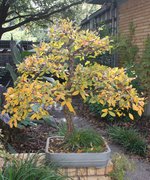Pigskin Pete
Yamadori
Cedar elms are one of the most common trees in my area. I've read they also do well as bonsai, back budding well and of course with beautiful rugged bark. Here is one article with pics as an example.
 bonsai-south.com
bonsai-south.com
They weed in my backyard as trash trees and I have collected three seedlings to play with and steward along with some other seedlings I got from josteen using an arbor day code. Of course, these may not be anything worthwhile as bonsai for many, many years.
When you are searching for yamadori, yardadori, or whatever term you like, but don't own your own acreage to hunt, what do you do? I have one friend who owns some rural acreage and I may ask him if I can scout his property for suitable stumps. Of course, i am just one giy with a shovel. Is that realistic? Other ideas for sourcing?
Also, when you decide you are in the market for a particular type of tree, how do you go about finding a market/sellers for it, and how do you educate yourself on being a good buyer who pays a fair price?
Best Bonsai Trees for Beginners – Cedar Elm | Bonsai South
They weed in my backyard as trash trees and I have collected three seedlings to play with and steward along with some other seedlings I got from josteen using an arbor day code. Of course, these may not be anything worthwhile as bonsai for many, many years.
When you are searching for yamadori, yardadori, or whatever term you like, but don't own your own acreage to hunt, what do you do? I have one friend who owns some rural acreage and I may ask him if I can scout his property for suitable stumps. Of course, i am just one giy with a shovel. Is that realistic? Other ideas for sourcing?
Also, when you decide you are in the market for a particular type of tree, how do you go about finding a market/sellers for it, and how do you educate yourself on being a good buyer who pays a fair price?



